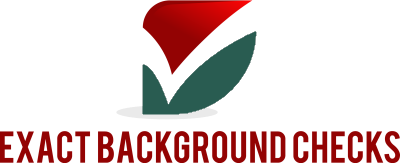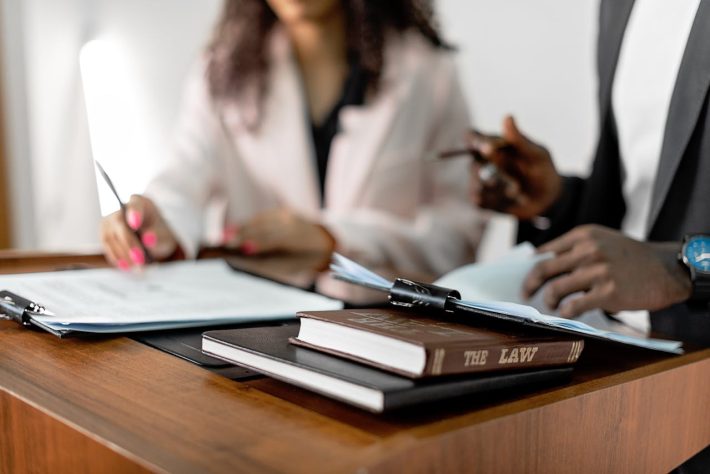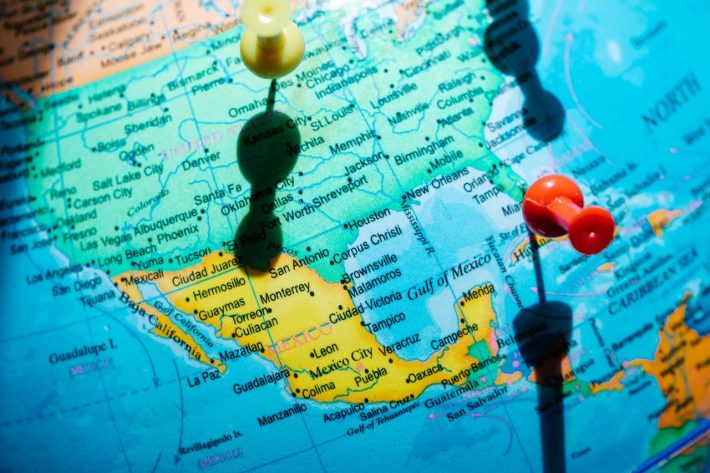Tips for Ensuring Reliable Drug Screening Cup Tests
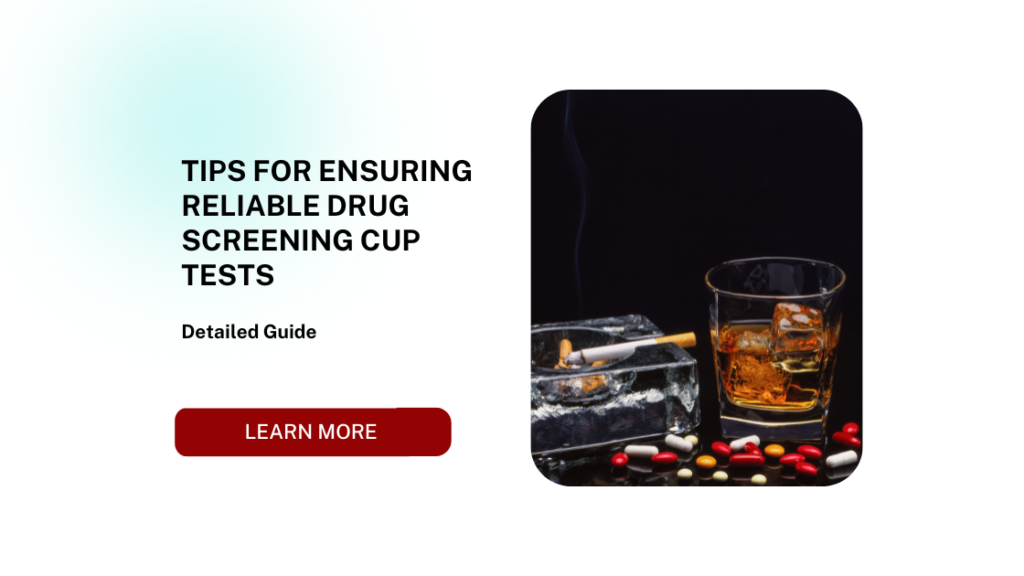
Everything You Need to Know About Drug Screening Cups
In recent years, drug screening has become an essential part of maintaining a safe and compliant workplace. Drug testing is commonly conducted for a variety of reasons—whether it’s to ensure safety, meet legal obligations, or evaluate candidates during the hiring process. Among the various methods of testing, drug screening cups have emerged as a highly convenient and effective solution. In this article, we will explore everything you need to know about drug screening cups, including their purpose, types, benefits, and how they are used in various testing scenarios.
What Are Drug Screening Cups?
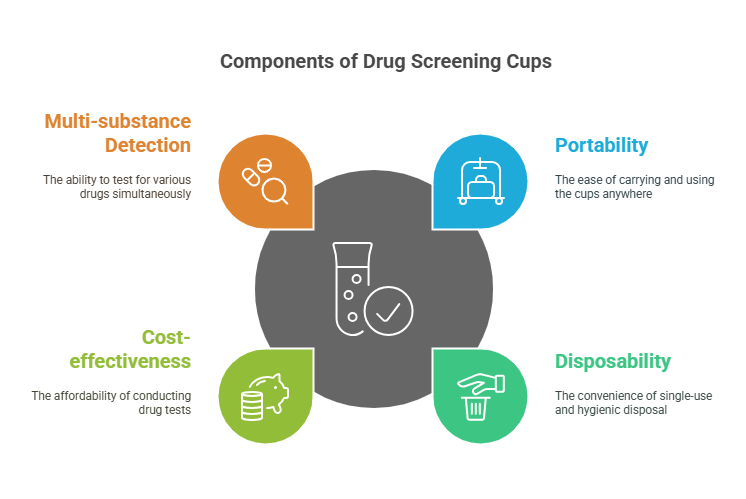
Drug screening cups are portable, disposable devices used for testing urine samples to detect the presence of drugs or their metabolites. These cups are designed to be a simple and cost-effective method for employers, clinics, or other organizations to perform drug tests on employees, job applicants, or athletes. Typically, a drug screening cup can detect multiple substances in one test, providing quick and reliable results.
The main advantage of using drug screening cups is their convenience. Unlike traditional lab testing, which may require a visit to a testing facility and can take several days to process, these cups provide instant results within minutes. This makes them ideal for on-site drug testing or random drug tests that need to be completed quickly.
Why Are Drug Screening Cups Important in Employment and Substance Abuse Testing?
Drug screening is essential in many industries where employee safety is a top priority. Whether it’s a pre-employment screening, random testing, or routine checks for employees in safety-sensitive positions, drug testing helps organizations ensure that their workers are fit for duty and not under the influence of substances that can impair judgment, reaction time, or performance.
Some of the main contexts in which drug screening cups are commonly used include:
- Workplace drug testing: Employers regularly use drug tests to maintain a drug-free work environment and prevent accidents due to substance abuse.
- Pre-employment screening: Employers often require job candidates to undergo a drug test to assess whether they are suitable for hire, particularly for positions that require high levels of responsibility or safety.
- Random drug tests: To maintain workplace safety, many companies conduct random drug tests to deter employees from using illicit substances.
- DOT (Department of Transportation) testing: Drivers and others in safety-critical jobs (such as in transportation or aviation) are frequently tested for drugs as part of federal and state regulations.
In addition to employment purposes, drug screening cups are also used in healthcare settings, sports organizations, schools, and rehabilitation centers for various testing requirements.
What Types of Drugs Can Be Detected by Drug Screening Cups?
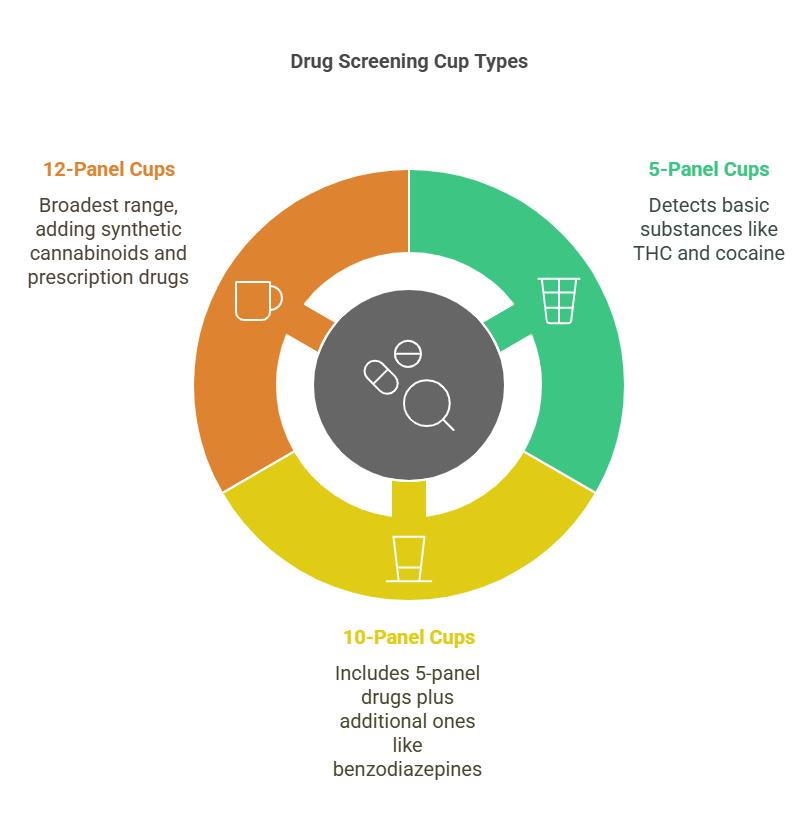
Drug screening cups come in various configurations, and their ability to detect specific substances depends on the number of panels they include. The most common types of drug screening cups are 5-panel, 10-panel, and 12-panel cups. These panels detect a range of drugs and substances, such as:
- 5-panel tests: Typically include marijuana (THC), cocaine, amphetamines, opiates, and phencyclidine (PCP).
- 10-panel tests: May include the 5 substances from the 5-panel test plus additional substances like benzodiazepines, barbiturates, methadone, and ecstasy.
- 12-panel tests: Offer even broader detection, including substances like synthetic cannabinoids, oxycodone, and other prescription drugs.
The exact configuration of a drug screening cup depends on the requirements of the testing organization and the regulations they are subject to. These cups provide highly accurate results, as they are designed to detect specific metabolites of drugs that can remain in a person’s system for a certain period.
The Accuracy of Drug Screening Cups
One of the key benefits of drug screening cups is their accuracy. Most modern drug screening cups use advanced technology, such as immunoassay techniques, to detect the presence of drugs. These tests are typically highly reliable, providing 99% accuracy in many cases when used correctly.
However, while drug screening cups are effective for initial testing, it is important to note that confirmatory testing may be required for certain results. If a drug screening cup indicates a positive result, it is generally recommended to send the sample to a certified laboratory for further analysis, especially when the stakes are high (such as for employment or legal purposes). Confirmatory tests, such as GC-MS (gas chromatography-mass spectrometry), provide additional accuracy and reliability.
Convenience and Privacy Advantages of Drug Screening Cups
The use of drug screening cups offers several key advantages over traditional urine drug testing methods. These advantages include:
- Convenience: Drug screening cups are portable, disposable, and easy to use. This makes them ideal for on-site drug testing in various settings, including the workplace, clinics, or sports facilities. They eliminate the need for employees or applicants to visit a separate lab.
- Quick Results: One of the primary benefits of using drug screening cups is the speed of results. Most drug screening cups provide results in as little as 5-10 minutes, which is much faster than traditional lab tests that can take several days.
- Privacy: With drug screening cups, the test is conducted in a private setting, and results are often more confidential. This is particularly important in the workplace and sensitive environments, where employees may appreciate the level of discretion.
- Cost-Effective: Drug screening cups are generally more affordable than sending samples to a lab for testing. This makes them an attractive option for businesses that need to conduct routine or random drug testing at scale.
Comparing Different Types of Drug Screening Cups
To help you understand the different options available, we’ve created a table that compares several common drug screening cup configurations. This table outlines factors like the number of drugs tested, detection time, and cost for each type.
| Type of Cup | Number of Drugs Tested | Detection Time | Cost Range |
|---|---|---|---|
| 5-Panel | 5 (THC, Cocaine, Amphetamines, Opiates, PCP) | 5-10 minutes | $3 – $8 per test |
| 10-Panel | 10 (Includes 5-panel + Benzodiazepines, Barbiturates, Methadone, Ecstasy) | 5-10 minutes | $7 – $12 per test |
| 12-Panel | 12 (Includes 10-panel + Oxycodone, Synthetic Drugs, etc.) | 5-10 minutes | $10 – $15 per test |
The prices can vary based on the supplier, the number of cups purchased, and any additional features the cups may offer, such as temperature monitoring, adulterant testing, or extended shelf life.
How Drug Screening Cups Work: Step-by-Step Process
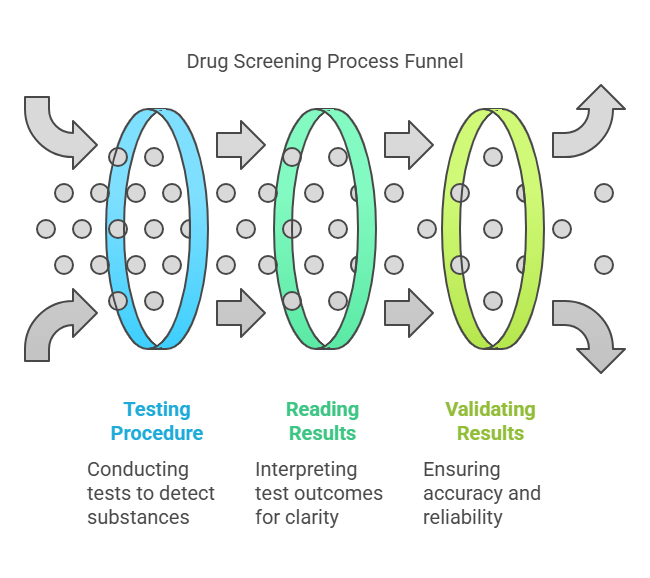
Drug screening cups are designed to be simple and user-friendly, making them an ideal solution for employers, clinics, and other organizations that need quick and reliable drug test results. Below is an overview of the standard process for using a drug screening cup.
1. Collecting the Sample
The first step in the drug testing process is to collect the sample. Typically, the sample is urine, as this is the most common method for drug testing. The individual being tested will provide their urine sample directly into the screening cup.
Most drug screening cups are designed to minimize contamination risks and ensure accurate results. The cups are usually equipped with secure lids to prevent spillage and leakage, and many cups come with temperature strips that help confirm the validity of the sample. The temperature of the urine is an important factor in determining whether the sample is authentic, as it must be within a certain range (usually 90-100°F) to be considered valid.
2. The Testing Procedure
Once the urine sample is collected, the cup is sealed, and the testing process begins. The drug screening cup has built-in testing panels, which are designed to detect specific substances. These panels are coated with antibodies that react with the metabolites of certain drugs. When the urine comes into contact with the panel, a chemical reaction occurs, producing either a visible line (positive or negative) or no line at all, indicating an invalid result.
3. Reading the Results
After the sample is added to the drug screening cup, it typically takes 5-10 minutes for the results to appear. The results are easy to read and generally consist of control lines and test lines:
- Negative Result: A single line in the control region and no line in the test region indicates that no drugs were detected in the urine sample. The test is considered negative.
- Positive Result: Both the control line and the test line will appear, indicating the presence of a specific drug or drugs in the urine. A positive result typically means that the individual has used a substance recently.
- Invalid Result: If no lines appear in the control region, or if the lines in the test and control regions are faint, the test is invalid, and the sample may need to be retested.
4. Validating and Confirming the Results
While the drug screening cup provides quick results, a confirmatory test may be required if the initial test is positive, especially in legal or employment contexts. This is where laboratory testing comes in, using techniques such as gas chromatography-mass spectrometry (GC-MS) to provide a more thorough analysis of the sample. Confirmatory tests are more expensive and time-consuming but offer a higher level of accuracy.
Advantages of Drug Screening Cups for Employers, HR Departments, and Clinics
Drug screening cups offer several advantages for employers, human resources (HR) departments, and healthcare providers. These benefits include:
1. Quick Results
The speed of the results is one of the biggest advantages of drug screening cups. While traditional lab-based testing can take several days, these cups provide results in as little as 5-10 minutes, which is essential for workplace testing and situations where immediate results are needed. This quick turnaround allows employers to make more informed decisions without unnecessary delays.
2. Cost-Effectiveness
Drug screening cups are relatively inexpensive when compared to the costs of laboratory testing. Employers can save money by conducting on-site testing using these cups, especially when dealing with routine or random drug tests. Additionally, these cups help eliminate the need for transport to a laboratory, reducing costs and administrative burden.
3. Ease of Use
The user-friendly design of drug screening cups means that they can be easily used by non-professional staff. The straightforward process of collecting the sample, applying it to the cup, and reading the results allows HR departments, supervisors, or medical staff to perform the test without specialized training.
4. Privacy and Discretion
Unlike traditional urine tests at testing centers, drug screening cups allow employees or applicants to provide their samples privately and discreetly. This is especially important for workplaces where privacy is a concern, as employees may feel more comfortable undergoing a drug test in a private and familiar environment.
5. Compliance with Industry Regulations
Drug screening cups can help employers meet regulatory requirements in industries where drug testing is mandated, such as transportation, aviation, healthcare, and construction. Many of these industries are subject to strict drug testing policies enforced by governmental agencies (e.g., the Department of Transportation (DOT)), and drug screening cups provide an efficient way to comply with these regulations.
Applications of Drug Screening Cups in Various Industries
Drug screening cups have a wide range of applications across multiple sectors. Here are some key industries and situations where they are used most frequently:
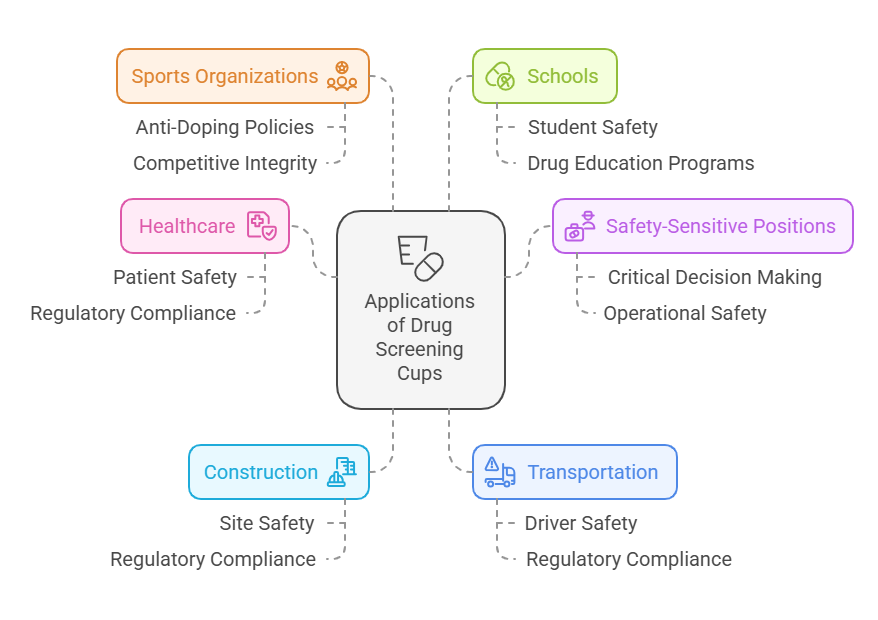
1. Healthcare and Safety-Sensitive Positions
In healthcare, especially in roles where employees work with patients or operate heavy machinery, employers need to ensure that staff members are not under the influence of drugs. Drug screening cups are frequently used for routine checks, pre-employment screenings, or post-incident tests in hospitals, clinics, and rehabilitation centers.
2. Construction, Transportation, and Safety-Critical Sectors
Certain industries, like construction and transportation, require workers to be alert and able to make quick decisions. Drug screening cups are used extensively in these fields to maintain safety standards. For example, truck drivers regulated by the DOT must undergo regular drug tests to comply with DOT drug testing rules. Similarly, workers in construction and manufacturing must adhere to drug-free workplace policies to avoid accidents and injuries.
3. Sports Organizations
Drug testing in sports is essential for ensuring fairness and preventing performance-enhancing drug use. Schools, universities, and professional sports teams use drug screening cups to test athletes before competitions or during random checks. These cups allow for rapid testing that helps maintain the integrity of sports events.
4. Schools and Educational Institutions
Some educational institutions conduct drug tests for students involved in extracurricular activities or as part of their admission process. Drug screening cups offer a quick and effective way for schools to screen students for substance use and maintain a safe environment for learning.
Exact Background Checks and Drug Screening Cups
Exact Background Checks provides comprehensive drug screening services that incorporate the use of drug screening cups for accurate and efficient employment verification. Their services are tailored to meet the specific needs of employers, including those in industries with regulatory requirements (such as DOT testing) or those that need random drug testing for their employees. Exact Background Checks streamlines the process by offering fast results, reducing the administrative workload, and ensuring compliance with industry regulations.
With their customizable options, employers can select from various drug testing panels based on the specific substances they wish to test for. Exact Background Checks ensures that all results are accurate, reliable, and legally compliant, providing peace of mind to employers and employees alike.
Legal Aspects of Drug Screening Cups
Drug screening and testing are subject to various legal regulations. Employers, healthcare providers, and organizations that conduct drug testing must be aware of the legal requirements to ensure compliance and avoid potential lawsuits. Below, we explore the most critical legal aspects related to drug screening cups.
1. Drug-Free Workplace Laws
In the United States, several federal and state laws require certain employers to maintain a drug-free workplace, particularly in safety-sensitive industries. Employers in sectors like transportation, aviation, and healthcare must adhere to drug testing regulations mandated by agencies such as the Department of Transportation (DOT), Federal Aviation Administration (FAA), and Food and Drug Administration (FDA).
The Drug-Free Workplace Act of 1988 mandates that employers receiving federal grants or contracts of a specified size must establish drug-free workplace policies. Employers are required to conduct drug testing in compliance with these laws to ensure a safe and drug-free work environment.
2. Consent and Privacy
Drug testing, including testing with drug screening cups, cannot be conducted without the consent of the individual being tested. It is essential for employers and healthcare providers to obtain written consent from the employee or applicant before administering any drug tests. This ensures compliance with privacy laws and protects the rights of the individuals involved.
In many jurisdictions, drug testing is considered an invasive procedure that must respect an individual’s privacy. Employers and testing organizations must handle the testing process discreetly and ensure that personal information is kept confidential. Test results must only be shared with authorized personnel, and results should be stored securely to prevent unauthorized access.
3. State-Specific Laws
While federal laws provide a broad framework for drug testing, state-specific laws can significantly affect how and when drug tests can be conducted. Some states have “ban the box” laws, which prohibit employers from asking about an applicant’s criminal history or drug use on initial applications, thereby limiting when drug testing can occur in the hiring process.
States like California, New York, and Massachusetts have specific laws governing drug testing in the workplace. For example, some states may allow employers to test employees or applicants only after a job offer has been made, while others may require the test to be conducted as part of a post-accident investigation or random screening program.
4. Legal Requirements for Different Industries
Each industry may have unique regulations regarding drug testing, and drug screening cups can be used to comply with these rules. For example:
- Transportation: The DOT requires random drug testing for employees in transportation-related fields, including truck drivers, pilots, and train conductors. DOT regulations specify the substances that must be tested for and the acceptable limits for each substance. Employers must also follow DOT guidelines on test timing and reporting.
- Healthcare: Healthcare organizations must ensure that employees who are involved in patient care are free from drugs that impair their ability to perform their duties. Drug screening cups can be used to test healthcare professionals to ensure that they are fit for duty, especially in high-risk areas like emergency rooms or surgery.
- Construction: The construction industry is subject to OSHA regulations, which require employers to maintain a safe workplace. Drug screening is often mandatory, especially for safety-sensitive roles. Testing is conducted before hiring, after accidents, and at random intervals.
Employers who use drug screening cups must also be familiar with the local laws and regulations related to drug testing to ensure they are fully compliant with industry-specific requirements.
Frequently Asked Questions (FAQs) about Drug Screening Cups
As with any type of testing, individuals and employers often have questions about drug screening cups. Below, we answer some of the most commonly asked questions regarding their use, accuracy, and limitations.
What are drug screening cups and how do they work?
Drug screening cups are portable, disposable devices that test urine samples for drugs or their metabolites. They use built-in testing panels with antibodies that react with specific substances, providing results in 5-10 minutes.
What types of drugs can drug screening cups detect?
They can detect various drugs depending on the panel configuration, including marijuana (THC), cocaine, amphetamines, opiates, PCP, benzodiazepines, barbiturates, and more, with common configurations being 5-panel, 10-panel, and 12-panel.
What are the main benefits of using drug screening cups?
The main benefits include quick results, cost-effectiveness, ease of use, privacy, and their ability to help employers comply with industry regulations.
How accurate are drug screening cups?
Most modern drug screening cups are highly accurate, often providing 99% accuracy with immunoassay techniques. However, positive results are typically confirmed with laboratory tests like GC-MS for legal or employment purposes.
What legal aspects should employers consider when using drug screening cups?
Employers must comply with drug-free workplace laws, obtain consent, respect privacy, adhere to state-specific laws, and follow industry-specific regulations, such as those from the DOT, FAA, and OSHA.
What are drug screening cups and how do they work?
Drug screening cups are portable, disposable devices that test urine samples for drugs or their metabolites. They use built-in testing panels with antibodies that react with specific substances, providing results in 5-10 minutes.
What types of drugs can drug screening cups detect?
They can detect various drugs depending on the panel configuration, including marijuana (THC), cocaine, amphetamines, opiates, PCP, benzodiazepines, barbiturates, and more, with common configurations being 5-panel, 10-panel, and 12-panel.
What are the main benefits of using drug screening cups?
The main benefits include quick results, cost-effectiveness, ease of use, privacy, and their ability to help employers comply with industry regulations.
How accurate are drug screening cups?
Most modern drug screening cups are highly accurate, often providing 99% accuracy with immunoassay techniques. However, positive results are typically confirmed with laboratory tests like GC-MS for legal or employment purposes.
What legal aspects should employers consider when using drug screening cups?
Employers must comply with drug-free workplace laws, obtain consent, respect privacy, adhere to state-specific laws, and follow industry-specific regulations, such as those from the DOT, FAA, and OSHA.
Conclusion: The Importance of Drug Screening Cups for Safe and Compliant Drug Testing
In conclusion, drug screening cups offer an effective, affordable, and quick solution for employers, HR departments, healthcare providers, and educational institutions that need to test for drug use. They provide fast results, maintain privacy, and ensure compliance with industry regulations while being simple to use.
Whether for pre-employment screening, random testing, or compliance with government regulations, drug screening cups offer significant advantages over traditional laboratory-based testing, including cost-efficiency, ease of use, and immediate feedback.
By incorporating drug screening cups into their testing procedures, employers can enhance workplace safety, meet regulatory requirements, and create a drug-free environment. Organizations like Exact Background Checks offer comprehensive drug screening services that incorporate these cups, ensuring that businesses can stay compliant with industry laws while promoting a healthy and safe workplace.
To maintain a safe and compliant work environment, it’s essential to implement best practices in drug testing, respect privacy rights, and comply with relevant legal requirements. Drug screening cups provide an invaluable tool for achieving these goals.
